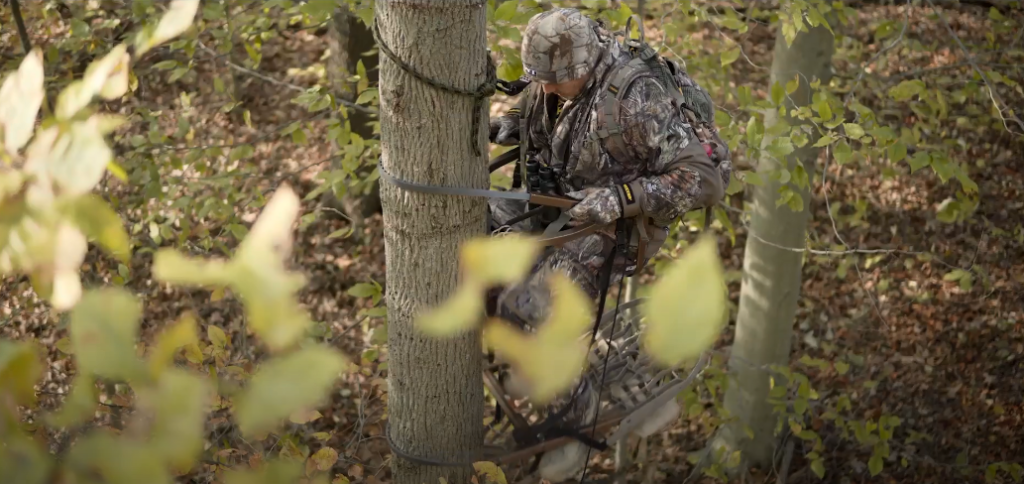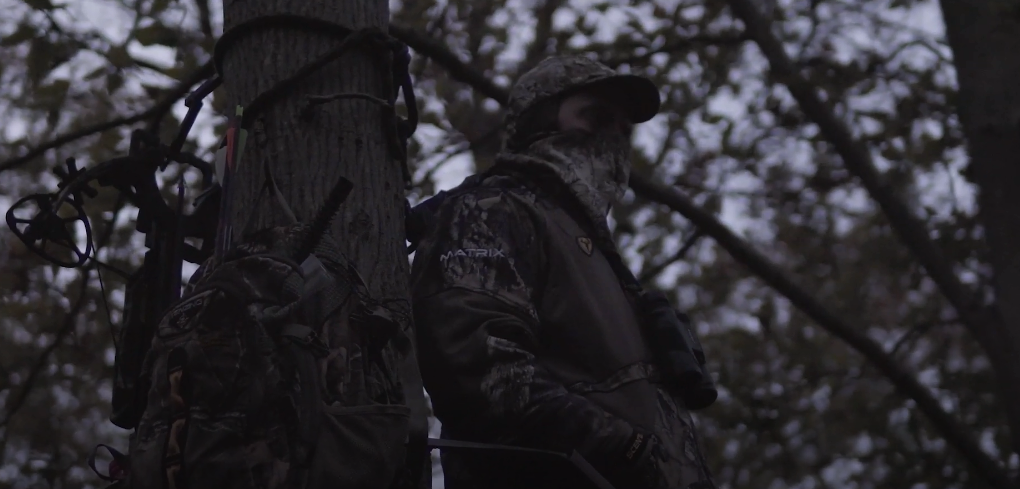As a hunter, you’ve almost certainly heard about fall-arrest systems (the short is FAS) – the special gear for those hunters who climb trees. However, for individuals who are always searching on the ground level, this probability may be quite remote.
Even if this is your first time hearing the name, you may make an accurate guess. The terms “Fall” and “Arrest” help us understand that it is the sort of safety equipment. This gear is used in a variety of fields, including hunting.
FAS is a collection of safety devices that stops a person from falling. The equipment consists of a harness for the body, anchoring, and a connector.

The anchoring is connected to a tree or other strong and sturdy object that is elevated above the ground. And the body harness is fastened to several body areas to ensure that the fall does not cause undue pressure on any one area. Finally, the connector secures your connection to the anchor.
Table of Contents
How is a Fall-Arrest System different from a Fall-Restraint System?
While FAS and fall-restraint gear are quite similar, they do have one critical differential. If misread, the consequences might be catastrophic. What is the critical distinction between fall arrest and restraint in the event of a fall?
FAS will arrest you fall-fall, but a fall restraint system will prevent you from reaching the edge and thereby preventing you from falling. Both are active fall prevention systems, however, they serve quite distinct purposes in various applications:
Fall-Arrest System
Typically, FAS consists of a safety lanyard, a set of anchor points, or self-retracting lifeline, and a harness. In the event of a fall, this system must be designed to “arrest” or halt you before you impact the lower surface. This allows you to work all the way up to a fall danger.
For instance, if you’re unloading a truck or working on railcars, your walking/working platform is so limited that any system that prevents you from getting close to the edge will severely restrict your mobility. Where complete access to your work surface is required, FAS is often the superior solution.
Climbing and descending a stationary ladder is another excellent demonstration of how effective fall arrest systems are. When mounting a ladder, there is no way to totally minimize the risk of falling. In this situation, the safety system must be capable of saving you when you slip or fall.
Fall-Restraint System
While they share many of the same components, a fall-restraint system (FRS) prevents you from approaching the fall danger near enough to fall. Consider a leash that keeps you a safe distance from the ledge. You are free to carry out your duties without fear of falling and even harming yourself due to your inability to reach the drop.
Related Reviews:
Additionally, FRS contains an anchor point, a lanyard, and the proper protective equipment (PPE), a safety harness. This equipment is ideal for large open-rooftops or decks with little construction required near a fall danger. A skylight, an unsecured rooftop hatch, or the edge of the platform may provide a danger.
Which system offers more safety to a hunter?
You may be obliged to utilize FAS or FRS in a variety of situations. Which is the safest choice in a situation when you have to select between the two?
Operating from a position that prevents you from falling is always the safest alternative. Functioning in the fall-restraint gear is always desirable if the circumstances allow this. It’s not because of a lack of safety and engineering in FAS; it’s because of the possibility of injuries occurring during the arresting process.

No matter how many safety precautions are taken, falling hurts. The truth is that falls are unpredictably unexpected. You could fall over backward, forward, trip, slide, get tangled up in a knot, or leap. Due to the hundreds of pounds of force on your body, any twisting, swinging, or landing awkwardly may result in injury.
If you work at heights, it’s critical to keep your training up to date. From the anchor point to the harness, you should have a solid and comfortable grasp of all parts of an active fall protection system. If you’re utilizing a fall arrest system, you should always have a rescue plan in place.
In the workplace, both FAS and FRS are useful. FAS may save your life, but they can’t ensure that you won’t be hurt. The use of FRS will restrict your mobility while also lowering your risk of damage. If you have a choice, always choose the one that prevents you from approaching the danger.
Safety guidelines to remember when using FAS
- Before hunting from an elevated stand, try adjusting and using your FAS, such as the suspension relief strap, at the ground surface with an adult present;
- Constantly wear your FAS harness, fastening it to the tree at the surface and maintaining it connected during your hunt to protect yourself if you fall;
- Use the FAS tree strap and tether to secure your FAS to the tree in any tree stand, including a ladder stand. When you’re standing, connect the tree strap to the trunk so that it’s at or above head level. Adjust the strap and tether after securing the tether so that there is no slack in the tether when sitting in your stand. If you slip, you don’t want to fall below a point where you can’t get back on the platform;
- Any FAS that shows indications of wear and tear or has been used during a fall should be discarded. Also, follow the manufacturer’s expiry date stitched into FAS;
- Hunters who do not properly wear and use their FAS should remain on the ground to hunt because of the danger of injury or death;
Here is what you should do if you fall while in the stand:
- Never panic because the reliable FAS can hold you;
- Signal to get help;
- Climb back to the platform as soon as you are on the feet again;
- Wait for the rescue, move your legs to avoid any suspension trauma;
When a hunter is obliged to wear a Fall-Arrest System?
In other words, anytime a hunter is off the ground, he or she should wear a full-body harness and FAS. When hunting valuable whitetails and other game animals, hunters often utilize tree stands to get a wider range of view. It also gives hunters more time to plan and execute a good shot.
Needless to say, if you plan and prepare to hunt from a tree, you must use a fall-arrest system to ensure your safety.

During climb and descent, hunters should constantly use a FAS/Full Body Harness and follow the manufacturer’s recommendations. Single-strap belts and torso harnesses are no longer approved or appropriate for usage.
What is the most crucial thing to remember if you slip or fall while carrying a pistol, for example? If you do fall or stumble, make every attempt to control the handgun under control with the muzzle pointed away from you and your hunting buddies. Point the rifle in a safe direction after a fall, open the action, empty the rifle, and inspect the barrel for any blockages.
FAQ
Who needs to use FAS the most?
Deer hunters often utilize tree stands to boost their success rate. As a result, more than half of all deer hunting events are caused by this. Hunters that use such tactics must utilize FAS to prevent a variety of mishaps. It will also help you if you have the opportunity to fall asleep while preparing for the game to begin.
Those who wonder when a hunter should use FAS should consider the scenarios listed above. Bowhunters like to hunt from tree stands. As a result, tree stand archery necessitates full-body harnesses and FAS. With rifles, however, hunting on the ground is perfect and does not need the use of FAS.
What equipment should you wear when using a tree stand?
When utilizing a tree stand, hunters should use a full-body harness or FAS in addition to a suitable outfit.
What game can you hunt when wearing FAS?
Whitetail deer is the most common game for hunters to hunt from a tree stand. However, since it provides the hunter with certain benefits, you may use it to hunt the animals as well. Wild turkeys, squirrels, leopards, porcupines, beavers, gray foxes, and other small to large animals may be killed with bows or appropriate guns.
Is it absolutely obligatory to wear a Fall-Arrest System when on a hunt?
You should use it to avoid falling from the tree or higher stand. Because the full-body harness and tree anchor are securely coupled through a connector, you can concentrate entirely on the processing of hunting.
The advantage of FAS is that it allows you to move freely and into any position that aids in correct aim. It prevents any individual, regardless of their weight, from colliding with the earth.
Those attempting to create one on their own should be cautious of the rules. The best FAS gear for hunters assures their safety and maximizes their advantages. You may follow the American Hunting Lease Association’s safety tips on this point.
Regardless of your level of experience or expertise, accidents may occur at any time and in any location. Therefore, avoid letting an adrenaline-pumping experience turn into a source of regret – use reliable FAS.
Final thoughts
Regardless of how tempting it may look to disregard safety equipment, you should understand its necessity and wear it whenever required.






Leave a Reply